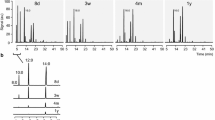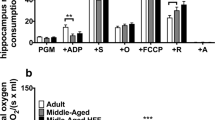Abstract
Decreases in brain docosahexaenoic acid (DHA) have been associated with losses in brain function leading to an interest in the conditions which lead to such brain decreases, and such variables as age. Also of relevance would be the rate of repletion of DHA when the n-3 dietary deficiency is reversed. This experiment describes dietary deficiency in n-3 fatty acids induced in weanling (3 week) and young adult (7 week) mice. There was an immediate and continuous loss of brain DHA with similar rates in the two age groups. Serum DHA declined more rapidly in younger animals with respect to similarly treated adults. Brain and serum docosapentaenoic acid (DPAn-6) increased more rapidly and to higher levels in the younger animals. A second experiment determined the rates of normalization of brain fatty acid profiles when alpha-linolenic acid was added to the diets of n-3 deficient mice. Brain DHA recovery occurred at a faster rate (half-time, T 1/2 = 1.4 weeks) when begun at weaning relative to young adult mice (T 1/2 = 3.5 weeks). Correspondingly, brain DPAn-6 recovered faster in the younger animals; the adult group had a half-time of more than twice that of the 3-week old group. This study therefore demonstrates that the young adult mouse brain DHA is somewhat plastic and can be partially depleted via a low n-3 fatty acid diet and subsequently restored when dietary n-3 fatty acids are repleted. Relevance of these findings for human nutrition is discussed.








Similar content being viewed by others
Abbreviations
- DHA:
-
Docosahexaenoic acid (22:6n-3)
- DPAn-6:
-
Docosapentaenoic acid (22:5n-6)
- DTA:
-
Docosatetraenoic acid (22:4n-6)
- EPA:
-
Eicosapentaenoic acid (20:5n-3)
- ARA:
-
Arachidonic acid (20:4n-6)
- ALA:
-
Alpha-linolenic acid (18:3n-3)
- LNA:
-
Linoleic acid, (18:2n-6)
- n-3 Adq:
-
n-3 Fatty acid adequate
- n-3 Def:
-
n-3 Fatty acid deficient
References
Stark KD, Beblo S, Murthy M, Buda-Abela M, Janisse J, Rockett H, Whitty JE, Martier SS, Sokol RJ, Hannigan JH, Salem N (2005) Comparison of bloodstream fatty acid composition from African-American women at gestation, delivery and postpartum. J Lipid Res 46:516–525
Kuriki K, Nagaya T, Tokudome Y, Imaeda N, Fujiwara N, Sato J, Goto C, Ikeda M, Maki S, Tajima K, Tokudome S (2003) Plasma concentrations of (n-3) highly unsaturated fatty acids are good biomarkers of relative dietary fatty acid intakes: a cross-sectional study. J Nutr 133:3643–3650
Dyerberg J, Bang HO (1979) Haemostatic function and platelet polyunsaturated fatty acids in Eskimos. Lancet 2:433–435
Farquharson J, Cockburn F, Patrick WA, Jamieson EC, Logan RW (1992) Infant cerebral cortex phospholipid fatty-acid composition and diet. Lancet 340:810–813
Makrides M, Neumann MA, Byard RW, Simmer K, Gibson RA (1994) Fatty acid composition of brain, retina, and erythrocytes in breast- and formula-fed infants. Am J Clin Nutr 60:189–194
Jamieson EC, Farquharson J, Logan RW, Howatson AG, Patrick WJ, Weaver LT, Cockburn F (1999) Infant cerebellar gray and white matter fatty acids in relation to age and diet. Lipids 34:1065–1071
Anderson RE, Benolken RM, Dudley PA, Landis DJ, Wheeler TG (1974) Polyunsaturated fatty acids of photoreceptor membranes. Exp Eye Res 18:205–213
Mohrhauer H, Holman RT (1963) Alterations of the fatty acid composition of brain lipids by varying levels of dietary essential fatty acids. J Neurochem 10:523–530
Bourre JM, Dumont OS, Piciotti MJ, Pascal GA, Durand GA (1992) Dietary α-linolenic acid deficiency in adult rats for 7 months does not alter brain docosahexaenoic acid content, in contrast to liver, heart and testes. Biochim Biophys Acta 1124:119–122
Pawlosky RJ, Salem N Jr (1999) Alcohol consumption in rhesus monkeys depletes tissues of polyunsaturated fatty acids and alters essential fatty acid metabolism. Alcohol Clin Exp Res 23:311–317
Pawlosky RJ, Bacher J, Salem N Jr (2001) Ethanol consumption alters electroretinograms and depletes neural tissues of docosahexaenoic acid in rhesus monkeys: nutritional consequences of a low n-3 fatty acid diet. Alcohol Clin Exp Res 25:1758–1765
DeMar JC Jr, Ma KA, Bell JM, Rapoport SI (2004) Half-lives of docosahexaenoic acid in rat brain phospholipids are prolonged by 15 weeks of nutritional deprivation of n-3 polyunsaturated fatty acids. J Neurochem 91:1125–1137
Kobayashi T (1963) Brain-to-body weight ratios and time of maturation of the mouse brain. Am J Physiol 204:343–346
Rodier PM (1980) Chronology of neuron development: animal studies and their clinical implications. Dev Med Child Neurol 22:525–545
Verma R, Mori S, Shen D, Yarowsky P, Zhang J, Davatzikos C (2005) Spatiotemporal maturation patterns of murine brain quantified by diffusion tensor MRI and deformation-based morphometry. Proc Natl Acad Sci USA 102:6978–6983
Reeves PG, Nielsen FH, Fahey GC (1993) Committee report on the AIN-93 purified rodent diet. J Nutr 123:1939–1951
Lepage G, Roy CC (1986) Direct transesterification of all classes of lipids in a one-step reaction. J Lipid Res 27:114–120
Moriguchi T, Loewke J, Garrison M, Catalan JN, Salem N Jr (2001) Reversal of docosahexaenoic acid deficiency in the rat brain, retina, liver, and serum. J Lipid Res 42:419–427
Bourre JM, Piciotti M, Dumont O (1990) Delta 6 desaturase in brain and liver during development and aging. Lipids 6:354–356
Bourre JM, Piciotti M (1992) Delta-6 desaturation of alpha-linolenic acid in brain and liver during development and aging in the mouse. Neurosci Lett 6(141):65–68
Weisinger HS, Vingrys AJ, Abedin L, Sinclair AJ (1998) Effect of diet on the rate of depletion of n-3 fatty acids in the retina of the guinea pig. J Lipid Res 39:1274–1279
Greiner RS, Catalan JN, Moriguchi T, Salem N Jr (2003) Docosapentaenoic acid does not completely replace DHA in n-3 FA-deficient rats during early development. Lipids 38:431–435
Tabata H, Bell JM, Miller JC, Rapoport SI (1986) Incorporation of plasma palmitate into the brain of the rat during development. Brain Res 394:1–8
Silver LM (1995) Mouse genetics concepts and applications. Oxford University Press, Oxford, UK. http://www.informatics.jax.org/silver/index.shtml
Chase DJ, Payne AH (1983) Changes in Leydig cell function during sexual maturation in the mouse. Biol Reprod 29:1194–1200
Ayala S, Brenner RR, Dumm CG (1977) Effect of polyunsaturated fatty acids of the alpha-linolenic series on the development of rat testicles. Lipids 12:1017–1024
Rapoport SI, Igarashi M, Gao F (2010) Quantitative contributions of diet and liver synthesis to docosahexaenoic acid homeostasis. Prostaglandins Leukot Essent Fatty Acids 82:273–276
Igarashi M, DeMar JC Jr, Ma K, Chang L, Bell JM, Rapoport SI (2007) Upregulated liver conversion of α–linolenic acid to docosahexaenoic acid in rats on a 15 week n-3 PUFA-deficient diet. J Lipid Res 48:152–164
DeMar JC Jr, DiMartino C, Baca AW, Lefkowitz W, Salem N Jr (2008) Effect of dietary docosahexaenoic acid on biosynthesis of docosahexaenoic acid from alpha-linolenic acid in young rats. J Lipid Res 49:1963–1980
Kim H-W, Rao JS, Rapoport SI, Igarashi M (2011) Regulation of rat brain polyunsaturated fatty acid (PUFA) metabolism during graded dietary n-3 PUFA deprivation. Prostaglandins Leukot Essent Fatty Acids 85:361–368
Lefkowitz W, Lim S-Y, Lin Y, Salem N Jr (2005) Where does the developing brain obtain its docosahexaenoic acid? Relative contributions of dietary α-linolenic acid, docosahexaenoic acid and body stores in the developing rat. Pediatr Res 57:157–165
Weisinger HS, Armitage JA, Jeffrey BG, Mitchell DC, Moriguchi T, Sinclair AJ, Weisinger RS, Salem N Jr (2002) Retinal sensitivity loss in third-generation n-3 PUFA-deficient rats. Lipids 37:759–765
Raper NR, Cronin FJ, Exler J (1992) Omega-3 fatty acid content of the US food supply. J Am Coll Nutr 11:304–308
Denomme J, Stark KD, Holub BJ (2005) Directly quantitated dietary (n-3) fatty acid intakes of pregnant Canadian women are lower than current dietary recommendations. J Nutr 135:206–211
Meyer BJ, Mann NJ, Lewis JL, Milligan GC, Sinclair AJ, Howe PR (2003) Dietary intakes and food sources of omega-6 and omega-3 polyunsaturated fatty acids. Lipids 38:391–398
Food and Nutrition Board IoM (2002) Dietary reference intakes for energy, carbohydrate, fiber, fat, fatty acids, cholesterol, protein, and amino acids (macronutrients). a report of the panel on macronutrients, subcommittees on upper reference levels of nutrients and interpretation and uses of dietary reference intakes, and the Standing Committee on the Scientific Evaluation of Dietary Reference Intakes. National Academy Press, Washington, DC
Howe P, Meyer B, Record S, Baghurst K (2006) Dietary intake of long-chain omega-3 polyunsaturated fatty acids: contribution of meat sources. Nutrition 22:47–53
Moriguchi T, Salem N Jr (2003) Recovery of brain docosahexaenoate leads to recovery of spatial task performance. J Neurochem 87:297–309
Carrié I, Clément M, de Javel D, Francès H, Bourre JM (2000) Phospholipid supplementation reverses behavioral and biochemical alterations induced by n-3 polyunsaturated fatty acid deficiency in mice. J Lipid Res 41:473–480
Kodas E, Vancassel S, Lejeune B, Guilloteau D, Chalon S (2002) Reversibility of n-3 fatty acid deficiency-induced changes in dopaminergic neurotransmission in rat: critical role of developmental stage. J Lipid Res 43:1209–1219
Ikemoto A, Ohishi M, Sato Y, Hata N, Misawa Y, Fujii Y, Okuyama H (2001) Reversibility of n-3 fatty acid deficiency-induced alterations of learning behavior in rat: level of n-6 fatty acids as another critical factor. J Lipid Res 42:1655–1663
Weisinger HS, Vingrys AJ, Bui BV, Sinclair AJ (1999) Effects of dietary n-3 fatty acid deficiency and repletion in the guinea pig retina. Invest Ophthalmol Vis Sci 40:327–338
Mathai ML, Soueid M, Chen N, Jayasooriya AP, Sinclair AJ, Wlodek ME, Weisinger HS, Weisinger RS (2004) Does perinatal ω-3 polyunsaturated fatty acid deficiency increase appetite signaling? Obes Res 12:1886–1894
Weisinger HS, Armitage JA, Sinclair AJ, Vingrys AJ, Burns PL, Weisinger RS (2001) Perinatal omega-3 fatty acid deficiency affects blood pressure later in life. Nat Med 7:258–259
Anderson GJ, Neuringer M, Lin DS, Connor WE (2005) Can prenatal n-3 fatty acid deficiency be completely reversed after birth? Effects on retinal and brain biochemistry and visual function in rhesus monkeys. Pediatr Res 58:865–872
Acknowledgments
This work was supported by the Intramural Research Program of the National Institutes of Health, NIAAA.
Author information
Authors and Affiliations
Corresponding author
About this article
Cite this article
Moriguchi, T., Harauma, A. & Salem, N. Plasticity of Mouse Brain Docosahexaenoic Acid: Modulation by Diet and Age. Lipids 48, 343–355 (2013). https://doi.org/10.1007/s11745-013-3775-5
Received:
Accepted:
Published:
Issue Date:
DOI: https://doi.org/10.1007/s11745-013-3775-5




